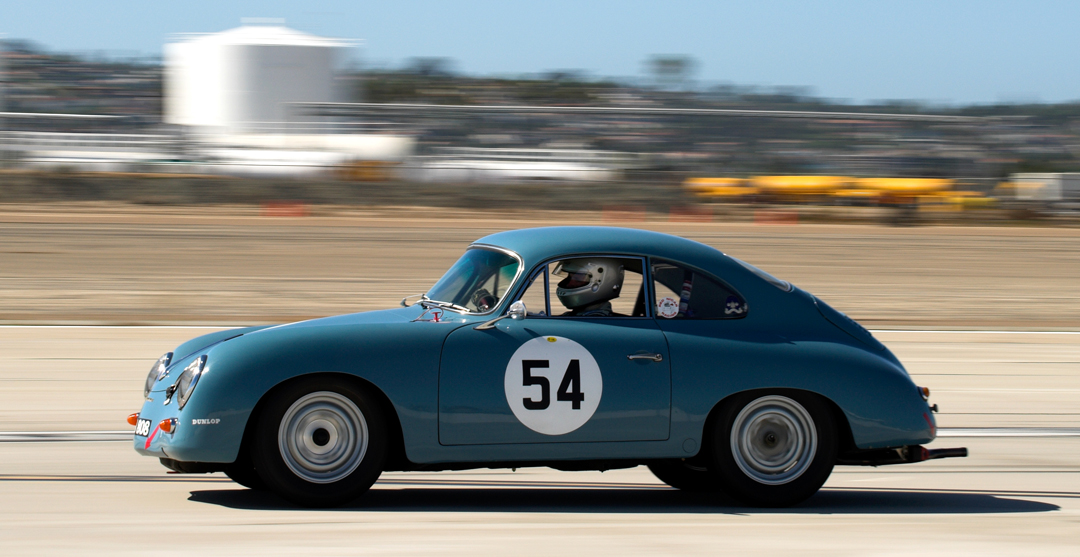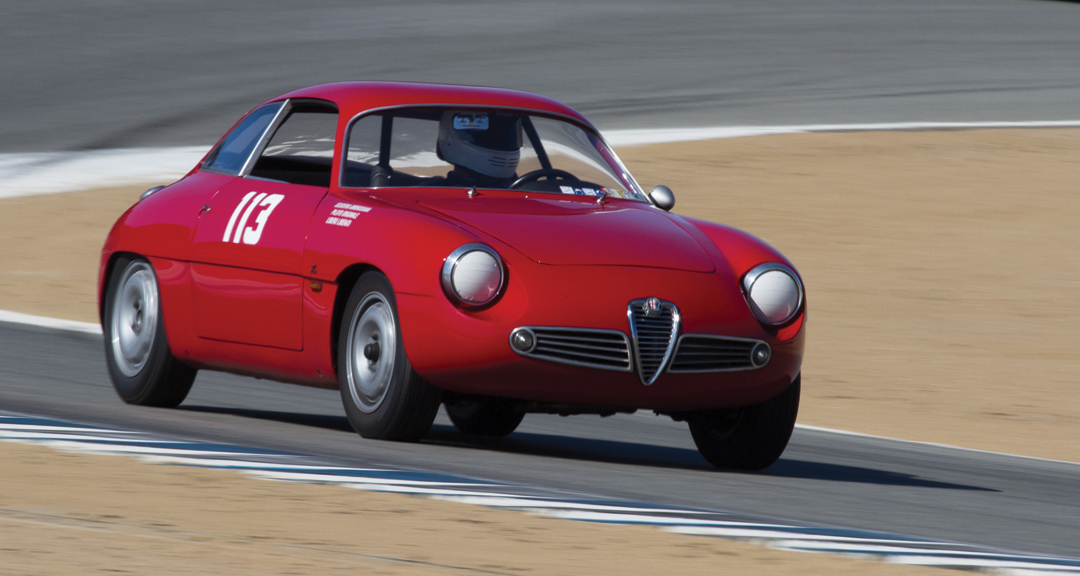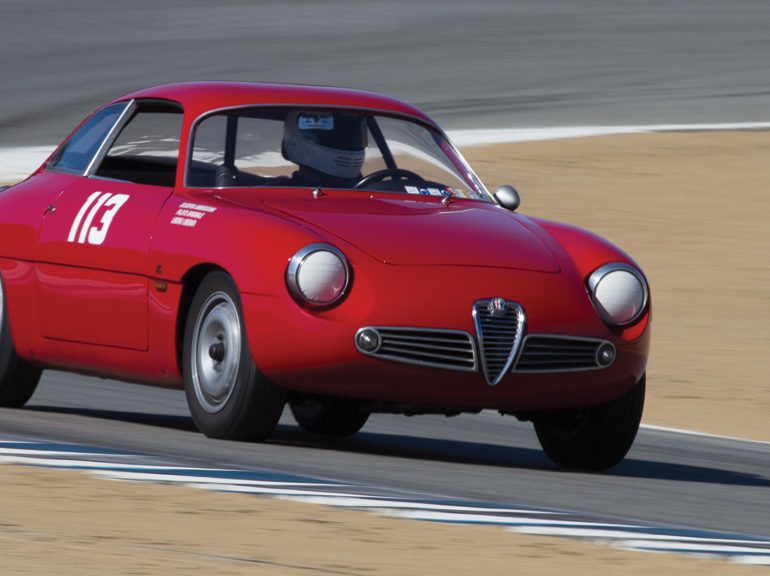The under 2-liter Grand Touring (GT) cars have always had a place to compete within the ever-changing regulations of international motorsports; the World Sports Car Championship from 1953-1961, the Speedworld Challenge from 1962-1963, the International Championship of Makes from 1964-1971 and the World Championship of Makes from 1972-1981. This included racing in the great endurance races such as the 24 Hours of Le Mans, the 1000 Kilometers of the Nürburgring, Spa and Monza, and the Targa Florio. Not to mention national races throughout Europe and SCCA races throughout the U.S. Alfa Romeo, Lotus, Porsche and Triumph all designed very lightweight successful competition cars. Abarth, an Italian specialty tuner, modified small-bore GT cars from Fiat and Simca, all with great success. These under-2-liter GT cars filled up the racing grids on both sides of the Atlantic and provided some exciting automobile racing.
Today under-2-liter GT cars qualify to race in many great historic events worldwide from the Rolex Monterey Motorsports Reunion to the Tour (de France) Auto because they are dual-purpose race and street cars. Due to their technology, great designs, eligibility and low production numbers, legitimate GT competition cars have steadily been increasing in value.
The value today of an under-2-liter GT car is determined by many factors including, the car still having its unique competition features available on a race version that were not available on a production version, the quality of restoration and a good provenance.
| Make | Model | Level III | Level II | Level I |
| Abarth – Fiat | 750/850 Zagato | $150,000 | $200,000 | $225,000 |
| 1000 Bialbero | $40,000 | $70,000 | $100,000 | |
| Abarth-Simca | 1300 GT | $150,000 | $200,000 | $250,000 |
| 2000 GT | $325,000 | $400,000 | $450,000 | |
| AC | Bristol Coupe | $125,000 | $150,000 | $225,000 |
| Bristol Roadster | $225,000 | $300,000 | $425,000 | |
| Alfa-Romeo | Giulietta Sprint/ Spyder/Veloce | $75,000 | $100,000 | $135,000 |
| Giulietta Sprint/Lightweight | $200,000 | $275,000 | $350,000 | |
| SVZ | $300,000 | $375,000 | $450,000 | |
| SZ1/ SZ2 | $300,000 | $400,000 | $475,000 | |
| GTZ-1 | $1,000,000 | $1,300,000 | $1,500,000 | |
| GTZ-2 | $2,500,000 | $3,000,000 | $3,500,000 | |
| GTA 1600 Corsa | $250,000 | $375,000 | $450,000 | |
| GTA Junior 1300 | $125,000 | $150,000 | $200,000 | |
| Alpine Renault | A110 | $75,000 | $150,000 | $200,000 |
| Arnolt-Bristol | Bolide | $225,000 | $300,000 | $400,000 |
| Austin-Healey | Sprite | $10,000 | $20,000 | $30,000 |
| Devin | Porsche | $40,000 | $50,000 | $75,000 |
| Elva | Courier | $15,000 | $35,000 | $45,000 |
| Frazer Nash | LeMans | $675,000 | $825,000 | $900,000 |
| Ginetta | G4/G4R | $40,000 | $75,000 | $125,000 |
| Lancia | Appia Zagato | $50,000 | $80,000 | $150,000 |
| B20 GT | $150,000 | $200,000 | $275,000 | |
| Flaminia Sport Zagato | $150,000 | $275,000 | $350,000 | |
| Lotus | Elite | $75,000 | $100,000 | $125,000 |
| Super 7 S.1/S.2 | $25,000 | $35,000 | $45,000 | |
| 26R | $175,000 | $200,000 | $250,000 | |
| 47 | $150,000 | $175,000 | $200,000 | |
| Maserati | A6G 2000 | $1,600,000 | $2,000,000 | $2,500,000 |
| MG | MGA Twincam | $30,000 | $65,000 | $95,000 |
| MGB | $10,000 | $25,000 | $50,000 | |
| Morgan | Plus 4 | $50,000 | $75,000 | $125,000 |
| OSCA | 1600 GTZ | $300,000 | $400,000 | $500,000 |
| Porsche | 356A Coupe | $50,000 | $75,000 | $125,000 |
| 356A Speedster | $150,000 | $175,000 | $250,000 | |
| 356A/Carrera GT Coupe | $800,000 | $1,000,000 | $1,500,000 | |
| 356A/Carrera GT Speedster | $1,000,000 | $1,500,000 | $2,000,000 | |
| 356B Carrera GT | $500,000 | $600,000 | $1,100,000 | |
| Abarth Carrera GTL | $3,000,000 | $4,000,000 | $5,000,000 | |
| 356B/C Carrera 2 GT | $800,000 | $1,000,000 | $1,300,000 | |
| 356B/C | $40,000 | $75,000 | $100,000 | |
| 904GTS | $1,500,000 | $1,800,000 | $2,000,000 | |
| Sunbeam | Alpine | $25,000 | $35,000 | $40,000 |
| Triumph | TR2/TR3 | $30,000 | $40,000 | $50,000 |
| TR4A IRS | $30,000 | $35,000 | $40,000 |
1959 Porsche 356A Carrera GT Speedster

The Type 356 was the 356th design of the Porsche engineering and design group. It was also Porsche’s first foray into building a production car. Shortly after building its first standard 356, and never losing sight of its desire to give customers a lightweight sports car for competition, Porsche developed a series of Carrera 356 examples with mechanical components from the famous competition spyders. One of the rarest and most collectible, and the last of the 356A series car, was the 1959 356A Carrera GT Speedster. It received the Type 692 1600-cc, four-cam, four-cylinder Carrera engine producing 140 bhp, with special exhaust and carburetion, a close-ratio transmission with limited-slip differential, big 60-mm vented spyder brakes, steel alloy construction wheels and an 80-liter long distance fuel tank with outside center hood fill. The interior was lightened, void of sound deadening, with lightweight aluminum seat shells, and a wooden Nardi steering wheel. The body had aluminum doors, front and rear lids and a bead around the bottom for rigidity. These are an example of Porsche’s unique engineering skills and competitive philosophy. Only 87 Carrera GT Speedsters were built with aluminum body panels.
1961 Alfa Romeo Giulietta Sprint Zagato

Alfa Romeo’s desire to build the Giulietta Sprint Zagato stemmed from a racing incident in the 1956 Mille Miglia where client, Massimo Leto di Priolo, crashed his Bertone-bodied Alfa Romeo Sprint Veloce. Rather than rebuilding with a standard body, Priolo asked Elio Zagato to rebuild the car so it would be lighter and faster. Utilizing the Sprint chassis, Zagato built a lightweight aluminum body for Priolo’s car, creating the Sprint Veloce Zagato (SVZ). Management at Alfa Romeo witnessed this new SVZ beating their Sprint Veloce in competition and began the design of the Sprint Zagato (SZ). Using the short-wheelbase chassis of the Spider Veloce, a tubular support structure was built to fasten the new body. Alfa Romeo also went to Carrozzeria Zagato to create a lightweight, aerodynamic aluminum body. Special tuning was performed by experts like Conrero to up the horsepower of the 1300 Giulietta engine. The first series, SZ1 was described as a round tail or Coda Tonda and the second series, SZ2, was described as clip tail or Coda Tronca. These cars led to the start of the Tubalare Zagato (TZ1). Only 217 SZ1-SZ2 cars were built. It was a unique time when an automobile manufacturer would use its resources to build a purpose-built lightweight car at such expense, which is one of many reasons this car is a highly collectable one today.
Criteria Used For Assessing Valuations for this Guide:
- Degree of Originality
- Overall Condition, Restoration
- Technology, Design, Coachbuilder
- Production Numbers/Rarity
- Competition History
- Ownership History, Documentation
- Modern Event Eligibility
Regional Variances
The prices stated in this guide are based on U.S. values. The values of historic racing cars can vary as much as 25%-35% in other countries, depending on local market appeal, currency rates, import duties, and VAT. Most of the time, we are able to document known sales or closed escrows, as they say in real estate. When this is not possible, a logical estimate of the car’s value is given, based on its sales history and relationship to cars of its type.
The prices stated in this guide are based on U.S. values. The values of historic racing cars can vary as much as 25%-35% in other countries, depending on local market appeal, currency rates, import duties, and VAT.
LEVEL |
VALUATION CATEGORIES |
|---|---|
I |
The best combination of all criteria. |
II |
Satisfies mid-range of criteria. |
III |
In need of restoration. Meets only a few points of criteria |




